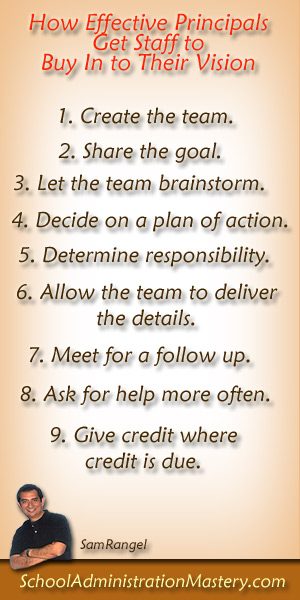After two years of sitting in the school administrator’s chair, I still find myself far from reaching my goal of School Administration Mastery. I have learned so much this year, and still I feel that I am not where I thought I’d be on this journey I’ve started.
I am grateful, however, for the lessons I have learned. I feel more comfortable in my position, and I know that as I continue to use every moment as a learning experience, I’ll be better prepared for when the powers that be see fit to place me in a position with even more responsibility.
I’ve worked under many principals in my career in education, and some have been more effective than others. All have wanted to have an impact on the school. All have wanted to move the school forward. All have wanted to see improvement in one area or another. Not all, however, have been successful in accomplishing this. Why is that?
I’ve learned that one of the biggest obstacles to a principal’s impact on a school is staff buy-in.
Every principal that I’ve known has a vision for the school. He / She has a particular goal or goals that he/she wants to reach as the leader of the school.
The tough part is getting the staff to jump on board and run with his/her vision.
So how do effective principals get their staff to buy into their personal vision?
Successful school administrators probably already know the answer, but I wanted to share what I’ve learned for other future principals like myself.
How Effective Principals Get Staff to Buy In to Their Vision:
Create the team.
This can be your department heads or your team leaders or a group of teachers who are seen as the leaders of the school. They give the team a name like, The VISION Team. It sounds a bit hokey, but it gives them a unique identity, instead of The Bunch of Teachers Trying to Improve the School Team.
Once the team is assembled, the principal will share his/her vision for the school and what he/she would like to see happen. He / She focuses on one or two specific goals that are measurable and attainable. Setting a goal of 100% of the student body testing proficient on the upcoming state test is not a reasonable goal. Lowering the number of D’s and F’s of the students at one grade level is not only reasonable, but measurable.
Let the team brainstorm.
The principal will allow the team to brainstorm. Someone (even the principal) will write down the ideas on a chart paper or on the whiteboard.
This is the tough part for the administrator. He / She already has ideas in his/her head, and wants to share them. An effective principal will have to let the teachers do the idea sharing. The principal can still guide the session with questions and comments. After all, he/she has done the research. He / She sees roadblocks and obstacles that they don’t see, because of his/her position and experience. Still, the plan has to come from the team. Teachers can be very creative. They will most likely come up with a strategy that will work better than the one in the principal’s head.
Decide on a plan of action.
When the brainstorming session is over, there should be a direction that can be taken to reach the goal. It’s written down, circled and underlined. It’s given a name. The “No More D’s and F’s Plan.” Please come up with something more catchy.
Determine a timeline.
When will this plan take effect? When will we gather data to measure its success? When do we meet again?
Determine responsibility.
Who does what and by when? Are there documents to create? Data to collect? Reports to build? The principal should try to get each member of the team a job to do. The principal makes sure that the team has the supplies and resources necessary to do their job. Most importantly, the team has to come up with the names of the people who will be sharing your strategies to the entire staff. This cannot be the principal.
Allow the team to deliver the details.
Now it’s time to spread the vision to the rest of the staff. In the next all-staff meeting, the principal will schedule in some time to talk about what the team has come up with. The principal will open the conversation by sharing the vision. Then it is handed over to the predetermined group of teachers who will give the details of the plan. This is where the buy-in happens. Since it’s a plan developed by their colleagues, the chances of getting more of the staff to support it are greater.
Meet for a follow up.
The team meets again after a reasonable amount of time to share data and see how effective the strategy has been. Determine next steps and make modifications to the plan if necessary.
Give credit where credit is due.
The team is given credit for any successes that come because of the new strategies put in place. Effective principals look to build their staff up instead of looking to make a name for themselves.
In my experience, I’ve learned that an effective principal will be willing to place their vision in the hands of others to accomplish. Ineffective principals will try and convince the staff that his/her vision and strategies are exactly what needs to be done.
I don’t know if I’ll ever find myself sitting in the principal’s chair, leading a school and promoting my vision to my staff, but I do know that I won’t be able to do it alone. No matter how motivating and inspirational my speech might be to the staff, I won’t be able to reach that goal without getting the staff to buy into it.
I hope this was helpful.
What do you think? Have you seen this in action? Please leave a comment or send me a tweet.
Until next time,
Here’s to your journey toward School Administration Mastery!
Thanks,
Sam


